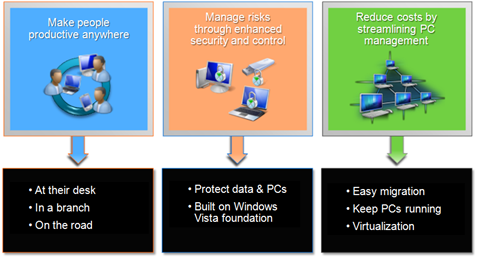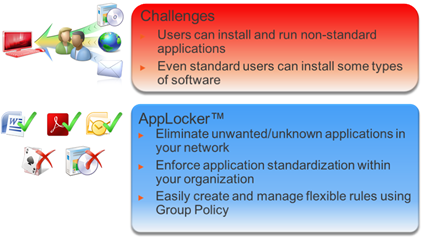Windows 7 in the Enterprise... The answers to all the common questions
This is it! Windows 7 is generally available today. We have waited and waited, and it is finally here. For all you IT Professional out there, let me highlight the 3 focuses and key innovations introduced in Windows 7 and make these links readily available for you here:
Making people productive anywhere
Making people productive is not that hard. In your office plugging company’s network with a laptop loaded with apps, you can be productive. Making people productive “anywhere” on the other hand is a very challenging effort for IT, facing the mass amount of mobile devices and increasingly complex network computing environment today. The growing numbers of mobile workforce and branch offices are at the same time demanding corporate resources seamlessly available regardless the required infrastructure and organizational boundaries. Two Windows 7 solutions to facilitate remote access are BranchCache and DirectAccess.
Managing risks through enhanced security and control
Security is nothing we need to much justify the need in today’s network computing environment. It is critical, imperative, and all too often costly. From Windows Vista, Windows Vista SP1, to Windows 7, BitLocker has been expanded from a single drive, multiple drives, now to portable media. Windows 7 offers security enhancements enabling a user to secure data from unauthorized access very easily with BitLocker-to-Go, for example. In Windows 7 Explorer, highlight a portable drive, right-click to turn on BitLocker-to-Go. It is that readily available, easy to do, and readable with Windows XP. There is really no reason not to do it since it is so little to do, yet with so much control and so strong protection on data. As a memory stick is now with 32 GB and beyond capacity, BitLocker-to-Go is one very cost-effective way to protect data from unauthorized access. For a large company, BitLocker technology with group policies offers a software based enterprise solution of hard disk encryption. You don’t need to look for a solution and end up a second-best solution. It is in Microsoft Vista and it is much enhanced in Microsoft Windows 7.
In an enterprise environment, software restriction is some of the most difficult enforcements. Not only it needs a mature infrastructure to provide software inventories, metering, and on-going monitoring, but the required an integrated skill sets to develop, test, and manage those software restriction policies are hoard to find, take years to develop, and come with very high costs. Windows 7 and Windows Server 2008 R2 together provide a vehicle that a system administrator can provision policies to deny/allow execution, installation, or usage of target software based on rules defined and enforced by group policies without programming. A complex requirement, for instance allowing task workers to access Office 2007 and later, but not PowerPoint when accessed by contractors, can be done with AppLocker in a few mouse clicking's without any scripting.
Reduce cost by streamlining PC management
Many thought without a direct migration path, i.e. in-place upgrade, from Windows XP to Windows 7, the deployment of Windows 7 may be tedious and tricky process. In fact, Windows 7 offers a number of vehicles making the migration an intuitive and straightforward process. For consumers and small businesses, Easy Transfer makes migrating from Windows XP to Windows 7 absolutely “easy” and, in my view, fun actually. Scanstate and Loadstate, two key utilities in USMT (User State Migration Tools) make a migration process very logical and easy to understand. Hard-Link Migration leaves and remaps data in place and significantly reduces the time needed to place large amount of user data in a typical migration scenario.
In the past two years, with Microsoft’s introduction of virtualization strategies and solutions, there are many options in resolving compatibility issues at an application or OS level while reducing TCO and increasing flexibilities in deploying and managing IT resources in the long run. Specific to Windows XP compatibility issues, Windows 7 Professional and above offer Windows XP Mode (via a free download) with a local virtualization of Windows XP SP3 machine. So those applications developed specific to Windows XP can now essentially run in a Windows 7 environment with a few steps to set up a Windows XP SP3 run-time environment. And Windows XP Mode is designed for small businesses. For large scale deployment, MED-V or Microsoft Enterprise Desktop Virtualization part of MDOP (or Microsoft Desktop Optimization Pack available through Software Assurance program) is the solution to manage local desktop virtualization with the abilities to standardize user experience, virtual machine settings, access control, etc. with policies.






